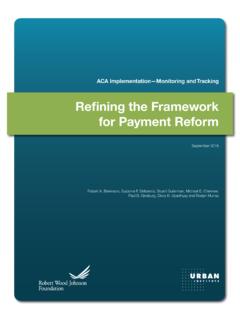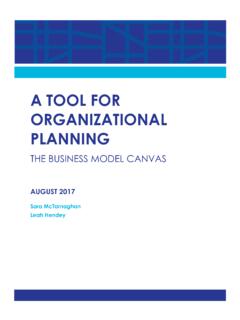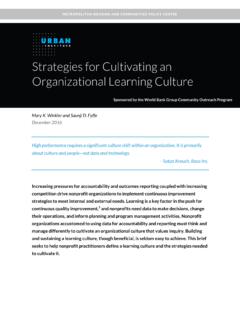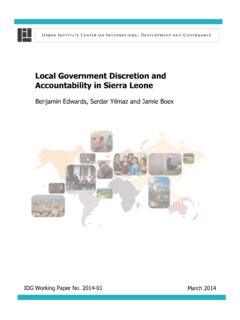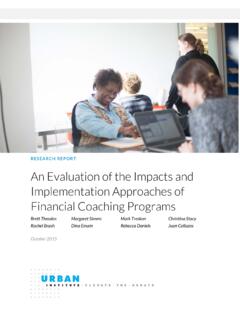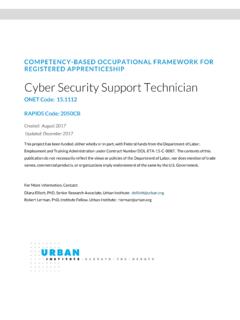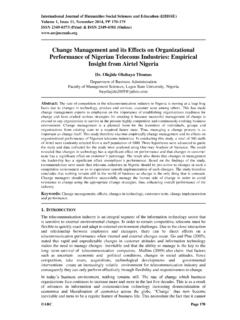Transcription of Employment after Prison: A Longitudinal Study of Releasees ...
1 Employment after Prison: A Longitudinal Study of Releasees in Three States URBAN INSTITUTE Research Brief Justice Policy Center October 2008. Most individuals released from prison held some type of job prior to Christy Visher incarceration and want legal, stable Employment upon release. Some criminal Sara Debus justice research suggests that finding and maintaining a legitimate job can reduce Jennifer Yahner former prisoners' chances of reoffending, and the higher the wage, the less likely it is that individuals will return to crime. KEY FINDINGS However, most former prisoners experience difficulty finding a job after release. Eight months after prison, 65 During the time spent in prison, many lose work skills and are given little percent of respondents had been opportunity to gain useful work experience.
2 Moreover, the availability of job- employed at some point, but only 45 training programs in prison has declined in recent years. percent were currently employed. A large proportion of former prisoners have low levels of educational Most respondents relied on family attainment and work experience, health problems, and other personal and friends for income after release, characteristics that make them hard to employ. For example, 40 percent of more so than legal Employment . state and federal prisoners have neither a high school diploma nor GED, nearly a third have a physical impairment or mental condition, and over half reportedly Respondents who held a job while in prison and those who participated in used drugs in the month before their arrest (Petersilia 2005).
3 Once in the job-training programs while community, not only are many employers reluctant to hire convicted felons, but incarcerated had better Employment many former prisoners are legally barred from certain occupations. outcomes after release. In this brief, we explore the reality of finding Employment after release from Once in the community, 48 percent prison from the perspective of 740 former male prisoners in Illinois, Ohio, and of respondents wanted but were Interviews were conducted as part of a comprehensive, Longitudinal unable to participate in programs to Study of prisoner reentry entitled Returning Home: Understanding the Challenges of improve their work skills, most Prisoner Reentry, which examined factors that contribute to successful or commonly because they were unaware unsuccessful reintegration into the community.
4 We focus on addressing the of program availability. following key questions: Most respondents who found work What are the Employment experiences of those being released from prison and did so by speaking with friends and returning home? family; however, the most successful What factors influence whether former prisoners find work in the year after release? strategy for long-term Employment was returning to a previous employer. Notably, our findings may reflect correctional practices at the time of data Respondents who were employed collection ( Study samples were recruited from 2002 to 2003 in Illinois and 2004. and earning higher wages after release to 2005 in Ohio and Texas), but do not necessarily reflect those currently in place.
5 Were less likely to return to prison the first year out. DESCRIPTION OF RETURNING HOME RESPONDENTS. The sample of 740 men was ethnically and racially diverse (74 percent African This Study was funded by the generous American, 16 percent European American, and 9 percent Hispanic). Almost all support of the JEHT Foundation. Any opinions expressed are those of the (99 percent) were United States citizens, and 43 percent had voted in an authors and do not necessarily reflect the election (table 1). The median age was 35 years. Before entering prison, a views of the Urban Institute, its board, or quarter were married and over half (56 percent) had children under 18.
6 About its sponsors. half had at least a high school education prior to prison. About three in five respondents reported using illegal drugs more than once a week in the six To learn more about Returning Home and months leading up to their imprisonment, with marijuana and cocaine each prisoner reentry, please visit our web site: accounting for about a third of reported drug use. This number increased to about two in three respondents when alcohol intoxication2 was also considered. Table 1. Characteristics of Respondents arrest was 17 years. Men The largest share of the sample (39 percent) was serving (n = 740) time for a drug offense (either possession or sales) for their Demographics current prison term.
7 Thirty percent were in prison for a Age (median) 35 years parole or probation violation, about a third of which were Black or African American 74% technical violations. The median time served was 15 months, White or Caucasian 16% and 5 percent were in maximum security for the majority of Hispanic 9% their prison term. Citizen 99%. Education and Family Relationships PRE-PRISON Employment EXPERIENCES. High school diploma or GED when entered prison 52%. Married or living together as married before prison 25% Many of the Returning Home respondents had an active Had children under age 18 when entered prison 56% Employment history before entering prison.
8 More than two- Pre-Prison Substance Use thirds (68 percent) had worked in the six months preceding Frequent drug use or intoxication 66% their incarceration, with most holding jobs in the Frequent illegal drug use 59% construction, maintenance, cleaning, automotive, and food Criminal History service industries. The majority (70 percent) had held a job Age at first arrest (median) 17 years for at least one year prior to entering prison, and the Served time in a juvenile facility 34% median hourly wage was $9 per hour. Besides Employment , Previously convicted of a crime 84% respondents reported a variety of other sources of income Served time in prison before 68% (figure 1).
9 Illegal income was a source of financial support for Had parole or probation revoked before 47% over a third (35 percent) of the sample. However, only 11. Current Prison Sentence percent reported that all of their income came from illegal Time served (median) 15 months activity. Violent offense conviction 20%. Drug offense conviction 39% IN-PRISON PROGRAMMING AND WORK EXPERIENCE. Current term due to probation or parole violation 30%. In maximum/high risk security 5%. About half of the respondents (53 percent) reported holding Released to parole or mandatory supervision 76%. a job during their incarceration (table 2). Nine percent had worked in the community in a work release job, earning Many respondents had a significant history of criminal an average of 20 cents per hour.
10 Many respondents (65. activity before the current incarceration. Eighty-four percent percent) also worked to learn new skills through education had prior criminal convictions with about a third having four and Employment programs while in prison (figure 2). Thirty- or more previous convictions. Sixty-eight percent had two percent participated in a GED or other educational served a prison term before (28 percent had served three program if it was available, with 35 percent of those or more prior prison terms), and 47 percent had been individuals who were offered or took an educational course returned to prison for a parole or probation violation at earning a GED.
